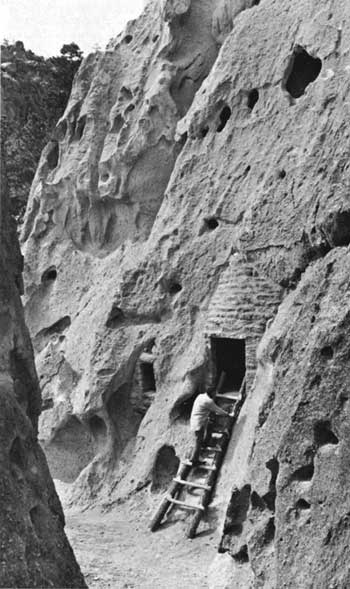|
BANDELIER National Monument |
 |

Entrance to Cave Kiva.
Principal Ruins of the National Monument
KIVAS. Associated with the numerous ruins in Frijoles Canyon are various kivas, both in the canyon floor and in the cliffs. The large kiva previously mentioned is a short distance east of Tyuonyi, very nearly in the center of the widest part of the canyon floor. The rock- walled circular pit is 42 feet across and 8 feet deep, with a ventilation shaft at the east side and a narrow entranceway opposite. When the roof was intact above the chamber, there must have been little evidence of the existence of the subterranean room; perhaps a ladder protruding from a center hole in the roof was the only conspicuous indication of the kiva below. In its present and partially restored state, this kiva shows the butt ends of six roof columns similar to those which once bore the load of the roof, as well as the stub ends of roof stringers. The restoration work in this kiva was accomplished by the Civilian Conservation Corps, which was responsible for much valuable work in the monument during the late 1930's.
Of particular interest in Frijoles Canyon are the unique kivas in the cliffs. Of the thousands of kivas found throughout the ancient land of the pueblos, there are no others of this cave style. The largest of the cave kivas in the monument is a few hundred feet north of Tyuonyi, at the base of a fantastically eroded block of tuff. The oval chamber, nearly 20 feet across its long dimension, has been restored by the replacement of rock work around its doorway and ventilation openings. The interior effect now presented, with soot-blackened ceiling, mud-plastered lower walls, and looms set in their ancient positions, must closely approximate the appearance of the kiva in the days when it was used. Many such kivas were decorated with painted or incised designs on the plaster of the walls. Although this particular kiva does not show evidence of mural paintings, it does still contain scratched designs in the plaster, unidentifiable because covered in part by later replastering.

|

|
|
Last Modified: Sat, Jan 6 2001 10:00:00 am PDT |


